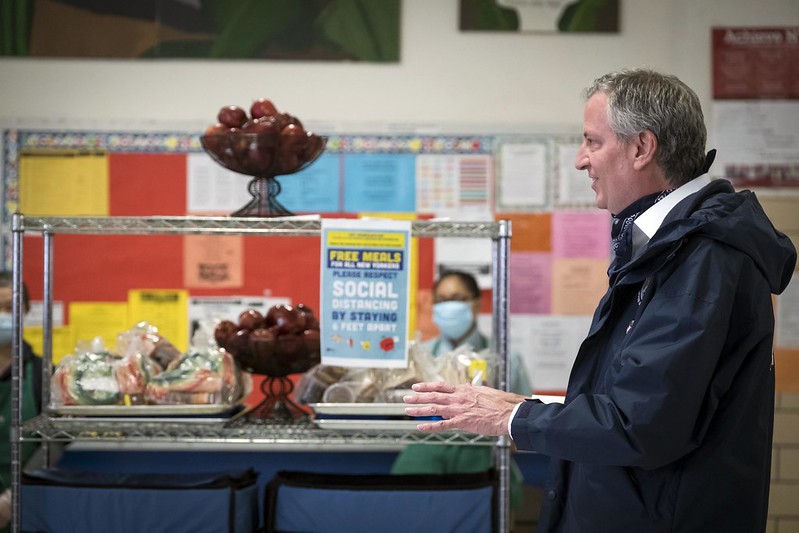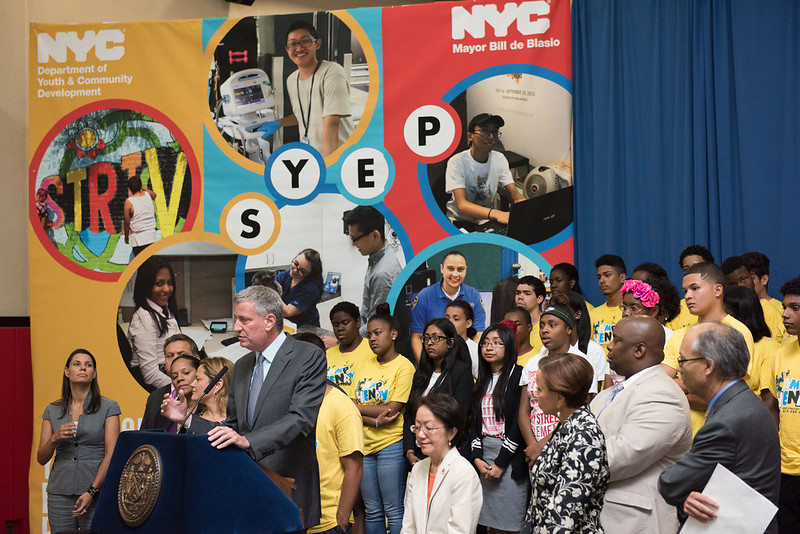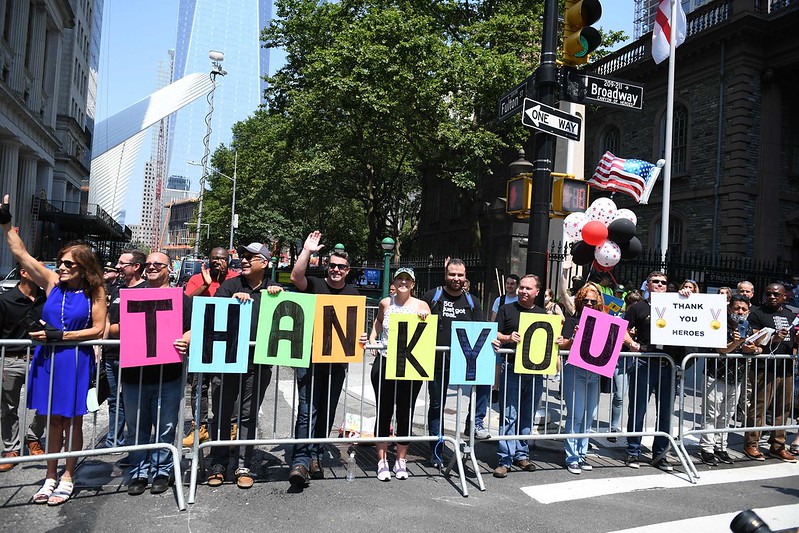Back to School Can’t Mean Back to Hunger; Here’s the Food Security Plan New York City Must Implement for Its Students

Mayor de Blasio at a school food site (photo: Ed Reed/Mayoral Photography Office)
In just a few weeks, more than 1 million New York City kids will head back to their school buildings — most of them for the first time since March 2020.
But the imminent return to a new normal in the classroom shouldn’t mean a return to the status quo when it comes to one of the biggest challenges our young people continue to face: hunger.
Before the pandemic, one in five New York City children struggled with hunger, meaning their families lacked the resources to consistently provide enough food. During the pandemic, that figure soared to one in four.
With so many kids at risk, the return to classrooms is both a challenge and an opportunity to do better. We can’t forget: the whole reason we’re climbing this mountain to reopen schools is to get our kids back on track and to be the best they can be.
But no child can reach their full potential in school while they’re facing hunger.
Many students are already facing a steep learning loss due to their time out of the classroom. Black, Latino and low-income students saw the steepest learning loss of all. As kids head back to school, the availability of free, nutritious meals will be critical to closing that gap and making sure all kids are fueled for success this school year.
So how do we achieve that?
First, we have to hold on to what works.
No Kid Hungry has spent years fighting for more alternative models for school meals that feed more kids — and we can’t let go of those wins now. Universal free school breakfast and lunch, breakfast in the classroom and “breakfast after the bell” all helped overcome barriers like social stigma and arcane bus schedules. Expanded vegan, Halal, and Kosher offerings ensured our diverse student body always had something nutritious to eat.
Now isn’t the time to walk away from what works. Let’s keep all of these programs running at full strength and adapt them as needed for social distancing and other safety measures.
Second, we need to make permanent the new programs that helped kids through the pandemic.
One of New York City’s biggest successes was the recognition that meals need to be readily available regardless of where kids are learning or where in the city a family lives. The hundreds of free meal hubs across the five boroughs where kids and families could pick up a meal at no cost all year-round were a game changer in the battle against hunger we’ve waged throughout this pandemic.
Even though New York City public schools are expected to return to full in-person learning this year, many families will still face inevitable closures or periods of quarantine as kids face exposure to the virus—and feeding those kids when they’re sent home has to be a priority. Continuing a flexible meal program — widely promoted in schools and communities – will help ensure all kids get nutritious food through the ups and downs this school year promises. And this same approach should continue to be a model for future summer meal programs as well.
Finally, we have to use this moment to break out of old thinking, and find new ways to reach more kids in need — because the hunger crisis caused by the pandemic will be with us for a long time.
One of the bright spots over the past year has been all the support from government: increased SNAP benefits for groceries, a larger Child Tax Credit, and Pandemic EBT. But we have yet to see a big push in New York City to enroll New Yorkers in programs they might be newly eligible for or to let them know what’s coming.
Here’s a simple solution — everyone who walks in the door of a public school, an ACS center, a homeless shelter, or any other office that provides social services should be automatically screened and enrolled in the most important food aid and child support programs. That will ensure every family has access to the hundreds—and in some cases thousands — of dollars now flowing through expanded federal aid that can help them put food on the table.
If we get this right, hundreds of thousands of kids across our city will have enough food both at school and at home, and we could see fewer kids facing hunger in our city than at any time on record.
But if we get this wrong, we’ll be failing to equip our children with one of the very most basic school supplies: the food they need to learn and reach their full potential.
The pre-pandemic status quo won’t be good enough. Let’s go above and beyond to make this the least hungry — and most successful — year in the history of New York City public schools.
***
Rachel Sabella is Director of No Kid Hungry New York. On Twitter @RachelS23 & @nokidhungry.
***
Have an op-ed idea or submission for Gotham Gazette? Email This email address is being protected from spambots. You need JavaScript enabled to view it.
Celebrating the Growth and Impact of New York City’s Summer Youth Employment Program

Mayor de Blasio makes an SYEP announcement (photo: Michael Appleton/Mayor's Office)
On August 21, the New York City Summer Youth Employment Program concluded its 59th year of operation after placing 74,884 New Yorkers into paid opportunities for six weeks. This was a record number of participants served (at a record 14,465 worksites), receiving life-changing paid career exploration and work experiences, with benefits extending well beyond the youth themselves.
As part of New York City’s Recovery for All, SYEP this summer launched innovative and timely new components such as the CUNY Recovery Corps, which served more than 4,000 CUNY students supporting small businesses, nonprofits, and other groups involved with our comeback from covid. The Clean-up Corps, another new program model this year, focused on neighborhood beautification. In keeping with ongoing public health concerns, SYEP opportunities this summer were available in-person, fully remote, or a hybrid of the two.
These successes also put an exclamation mark on eight years of extraordinary growth and evolution for SYEP under the de Blasio administration.
In 2013, the last year of the Bloomberg administration, SYEP served 35,997 participants. This was roughly in line with the average over the previous decade: the size of SYEP grew and shrank by the year under Mayor Bloomberg, subject to the outcome of his annual budget battles with City Council. Program services themselves were largely undifferentiated between different groups of youth: participants applied and were selected through a series of lotteries, and placed into jobs developed by neighborhood providers.
All this changed under Mayor de Blasio, who steadily grew SYEP between 2014 and 2019 until it was more than twice the size of the last Bloomberg-era cohort. This growth was driven by New York City’s direct investment in the program, which skyrocketed from around $21 million in 2013 to $134 million six years later. The funding increase covered the expansion of the program, the boost to New York State’s minimum wage up to $15 per hour, and the development of new service options within SYEP.
Crucially, city budgets invested in the system infrastructure necessary to operate a great summer jobs program. The mayor empowered and invested in the Department of Youth and Community Development, which administers SYEP. He also created the Center for Youth Employment, which works to support the full ecosystem of career readiness by aligning K-12 schooling, higher education, and youth workforce programs such as SYEP.
Maybe most important, Mayor de Blasio and the City Council agreed to baseline SYEP into the annual budget in June of 2016, removing it as a political football and setting the stage for significant gains in program quality.
These improvements to SYEP—making the program not just bigger, but tangibly better—are a proud legacy for this administration. They include:
-Greater targeting of high-need youth, by reallocating a number of slots from the lottery to defined eligibility programs such as Emerging Leaders (serving youth in the foster care, homelessness, and juvenile justice systems) and program options for NYCHA residents.
-Creation of CareerReady SYEP, a defined-eligibility school-based program option that links summer work experience to year-round learning for high schools serving student populations with significant economic need.
-More intentional sequencing of the program by implementing a project-based learning model for “Younger Youth” ages 14-15.
-Financial empowerment for young people resulting in more youth signing up for direct deposit (from 7% in 2014 to 59% in 2020).
-Significant growth in the number of private sector job placements over the course of this administration.
As with so much else in New York City, the administration’s support for SYEP was severely tested when COVID-19 struck in 2020. The public health crisis and ensuing recession rendered the traditional program model impossible to run. The Department of Youth and Community Development and Center for Youth Employment worked closely with the provider community and grassroots advocates to quickly develop a remote program. Thanks to their efforts, and with generous support from private funders and participating employers, SYEP Summer Bridge ultimately served more than 35,000 participants with career exploration and project-based learning.
Then, like so much else in New York City, SYEP bounced back this year, with nearly 75,000 participants.
SYEP shows the power of the public sector to improve people’s lives in both the immediate and long-term. The new administration set to take office on January 1 will inherit a precious asset in SYEP—one that we have made great efforts to grow and nourish. Supported well, it will offer a robust return on investment, not only in wages earned and taxes paid, but in an even more important measure: helping youth fulfill their highest aspirations.
***
Bill Chong is the Commissioner of the New York City Department of Youth and Community Development. David Fischer is the Executive Director of the NYC Center for Youth Employment. On Twitter @NYCYouth & @cyenyc.
***
Have an op-ed idea or submission for Gotham Gazette? Email This email address is being protected from spambots. You need JavaScript enabled to view it.
How New York City Must Support Low-Wage Essential Workers as They Support Everyone Else

(photo: Ed Reed/Mayoral Photography Office)
Luz is a home care worker in New York City who routinely logged 24-hour shifts caring for patients in their homes during the start of the COVID-19 pandemic. (Luz is a pseudonym to protect her privacy.)
As a frontline worker, she was especially susceptible to the virus, yet she was forced to purchase her own gloves, masks, and other PPE because her employer refused to provide them. Despite the grueling hours, unsafe working conditions, and persistent wage violations, Luz could not leave her job because her family depends on her steady paycheck. But through New York City’s Low-Wage Worker Initiative (LWWI), Luz and her colleagues bravely came forward to file a lawsuit in federal court against their employer, a home health agency, for unpaid wages.
The lawsuit and other cases like it offer an opportunity for these essential workers to improve the jobs on which our city relies. They also require a substantial amount of attorney time and case management resources, as well as multi-year, sustainable, and reliable funding from the city for the LWWI to see it through. But right now, the program remains under-funded. New York City must adequately and reliably fund the LWWI expansion, by allocating $4 million in the current fiscal year (FY22) and ensuring multi-year funding moving forward.
For many low-wage workers like Luz and her colleagues, obtaining private counsel is prohibitively expensive. Often, the worker’s damages from a case are less than the actual cost for a private attorney to bring the case forward. Created in 2019, LWWI is the only dedicated city-funded program that provides free, individually-tailored, employment civil legal services and case management support to workers in New York City’s low-wage industries. These services enable workers to seek redress from wage theft, discrimination, harassment, unsafe working conditions, and other workplace violations. Each year, LWWI helps thousands of low-wage workers -- the overwhelming majority of whom are from Black, Latino, Asian, and immigrant communities -- access justice so they can enforce their legal rights.
Despite LWWI’s proven track record of recouping millions of dollars annually in unpaid wages through judgements and settlements for essential workers, the program’s funding has not kept pace with demand for its services. New York City has chosen to fund the program on a year-by-year basis rather than providing multi-year funding. The resulting uncertainty makes it difficult for LWWI service providers -- community-based organizations, grassroots worker centers, and advocacy groups -- to know if they can continue serving clients like Luz when they do not know if LWWI funding will be renewed in the coming year. A lack of expanded and multi-year funding for LWWI hurts low-wage workers’ chances of achieving economic justice, and could significantly reduce or eliminate the resources we need to help them obtain assistance and enforce their rights.
To more effectively address this issue, the Citywide Immigrant Legal Empowerment Collaborative (CILEC), has been zealously advocating for LWWI funding to be expanded and reliably funded. Having exhausted all other options, CILEC is now calling upon New York City’s Office of Management and Budget (OMB) and City Hall to increase funding for LWWI to $4 million in Fiscal Year 2022 and re-assess multi-year funding for it moving forward. This is critical to keep pace with the demand for services, which has increased exponentially due to the COVID-19 workplace violations and health and safety concerns that essential low-wage and immigrant workers have been grappling with.
Luz’s story is unfortunately representative of many essential workers struggling to survive this pandemic, while victimized by wage theft, discrimination, harassment, anti-union threats, safety violations, trafficking, and other forms of workplace mistreatment. Throughout the COVID-19 pandemic, the exploitation and abuse that have always been pervasive in low-wage industries have continued.
Instead of “staying at home” or “sheltering in place,” essential low-wage and immigrant workers were forced to risk their lives for substandard pay and with inadequate safeguards, and to benefit those staying safe at home. They were delivering food from restaurants and grocery stores, tending to the sick and elderly as home-care attendants, providing childcare as domestic workers, cleaning homes and hospitals, working in laundromats, and packaging supplies in cramped warehouses. They are heroes of this pandemic, but have been faced with a cruel choice: survival depends on an ability to continue working, yet exposure to a deadly virus and exploitative working conditions pose grave risks.
The situation is even worse for workers who lack immigration status. Their labor made it possible for others to stay home, but their employers continue to exploit them by skimping on wages and safety measures. A recent report from the Center for Migration Studies of New York highlights America’s reliance on immigrant workers during this crisis, finding that 74% of undocumented workers are employed in “essential” infrastructure industries.
In the coming weeks and months, New York City workplaces will continue to reopen and will rely more than ever on essential workers to support the city’s economic recovery. While we cannot fully control the course of the pandemic, we can modify our systems, resources, and infrastructure now to better protect our essential workforce through employment-related civil legal services. This requires support from the city.
Now is the time when workers in New York City’s low-wage industries, like Luz and her colleagues, most need reliable “Know Your Rights” community trainings and information sessions about their workplace rights, and zealous legal representation and case management support when these rights are violated.
City government should lead the way in ensuring an equitable and just economic recovery for New Yorkers, and demonstrate its support by adequately and reliably funding LWWI. Our city’s workers, and ability to weather new waves of infections, depend on it.
***
Thomas Power is a Senior Staff Attorney at Catholic Migration Services. Sarah Leberstein is a Supervising Attorney at Make the Road NY. Katisha Andrew is the CILEC Coordinator at TakeRoot Justice. All three organizations are member organizations of the Citywide Immigrant Legal Empowerment Collaborative, a consortium of nonprofit legal services providers and community-based organizations. On Twitter @MaketheRoadNY, @CMSBQ & @TakerootNYC
***
Have an op-ed idea or submission for Gotham Gazette? Email This email address is being protected from spambots. You need JavaScript enabled to view it.




